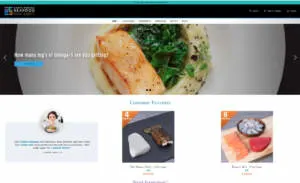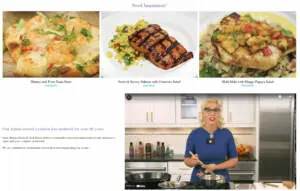Santa Monica Seafood Explores a Sea of Opportunities by Expanding to Direct-to-Consumer

Santa Monica Seafood was officially founded back in 1939 on the Santa Monica Pier. One or two things have changed over the years. They still offer the highest quality and selection of seafood to restaurants and customers at their two Southern California retail locations. However, now customers nationwide can experience their lobster tails, swordfish and more through their Dock Direct online store.
The COVID-19 pandemic has had a significant impact on people worldwide, affecting everything from their jobs and social lives to how they shop and where they eat. Overnight many of the restaurants the seafood brand company supplied were shuttered. At the same time, those restaurants’ former customers were missing the seafood dishes they formerly enjoyed. The direct-to-consumer business exploded as people decided to try cooking their favorites for themselves.

Fishing for the Right Fit
As Santa Monica started to investigate expanding their direct-to-consumer ecommerce business, they knew they needed to continue to prioritize their customers and give them the best possible experience. They also knew, as they were still figuring out how this new customer base was shopping, they would need a flexible site that would let them make changes quickly.
As Alfredo Chavez, Director of Ecommerce at Santa Monica Seafood, explains: “We had a deep relationship with our customers we wanted to continue. The amount of flexibility that was offered by the platform was key to us because we didn’t know exactly what our direct-to-consumer offering was going to look like. We had some broad strokes. But we didn’t know, for example, that it’s very important to customers that they be able to choose the shipping date. And we didn’t know if they would prefer to choose the species or have it pre-selected because buying fish was new to them.”
They considered Magento and Shopify Plus before settling on BigCommerce. Khai Vuong, Director of IT for Santa Monica Seafood, explains: “We wanted to get into a platform that would allow us to grow to thousands, and potentially millions, of transactions per month. So that’s why we started the journey, looking at multiple solutions out there. BigCommerce strikes the perfect middle ground between the large, complex solutions, such as Magento, and a smaller, more agile but restrictive solution, such as Shopify.”
Magento was quickly removed from the options because of the high development costs. “Magento would require more from the IT team to maintain. The security implications, the patching and some of the support on creating content on our web store, maintaining some of the marketing campaign, we considered all of that,” says Vuong.
Chavez explains why BigCommerce ultimately won out over Shopify: “Once we started really digging in and talking to our developers as well, BigCommerce became the easiest choice. It offered the most flexibility, both in terms of programmatically and how easy it was to make adjustments.” Chavez appreciates that his team can easily make adjustments to themes as needed.
A Site That Works for Everyone
The flexibility was incredibly important because it allowed Santa Monica Seafood to make a site that worked both for developers on the backend and the marketing team on the frontend.
“One of the advantages of BigCommerce that really stood out is the Page Builder widget,” says Vuong. “That allows our creative director to not only create the store, but also to maintain the content of the store without involvement from IT. That is absolutely crucial for us, as we go through the pandemic and approach the migration of our entire business over to a new ERP system. The IT team really needs to focus on the ERP side.”
Speaking from the marketing side Chavez adds: “I have all the freedom to do whatever I want to build this up. With a tool like BigCommerce, it’s easy. So, I never worry about, ‘How do I do that? How do I put a banner up? How do I end this promotion or start a promotion? How do I offer a buy-one-get-one-free [offer]?’ All that stuff is just built in. Once you’ve used it once, that’s it. You’ve learned it. It’s like a bicycle, you’re not going to forget how to do it.”
Santa Monica Seafood leverages headless commerce — that is using a separate frontend and BigCommerce for ecommerce on the backend — to provide even greater flexibility. Vuong explains: “The headless commerce aspect allows us to get a store up and running quickly, capitalize on the market that was out there and start broadcasting our presence out to our consumers. But it allows us the flexibility and the power to grow into something vastly larger than what we even had in mind when we started out.”
Giving Customers What They Want
Adaptability has been incredibly important as Santa Monica Seafood has explored new markets and new customer bases. Chavez has been able to experiment to explore ways to improve the conversion rate and give customers what they want.
“When I started running Google ads, I was getting a good amount of traffic, but I was getting very low conversions,” says Chavez. “I went in. I changed some verbiage. I added a first purchase coupon of 10%, all on my own, and my conversion rate went up. The customer needs a little bit of incentive to complete that purchase. We can do that.”
But not all customers were coming through Google Ads, so Chavez made sure to address all touchpoints to leave no customer behind. “We added the 10% to a banner on the landing page and as a coupon when you sign up for the newsletter. At every step of the way, it was easy to communicate to my customers, because BigCommerce has the tools. We also enjoy the seamless integration with Klaviyo to work the offer into our email flows. So every chance I get, we provide a possibility for a customer to know about that first 10% coupon.”
The company is also listening to its customers when it comes to feedback. Some didn’t like that they were using styrofoam packaging, so they shifted to curbside recyclable packaging. Another way they’re addressing their DTC customers’ needs is by adapting the fulfillment process to address all preferences. For example, when customers wanted a curbside pickup option from their two retail locations, they were able to add that easily. They’re also using ReCharge, which integrates with BigCommerce, to create a subscription plan so customers can set up recurring deliveries.
Teach a Man to (Cook) Fish

One more way Santa Monica Seafood supports their new customer base is by providing content in the form of recipes to help shoppers master cooking their favorite dishes and explore new ways to enjoy seafood.
“The BigCommerce blog allows us to very easily create and maintain recipes, which is very important to drive customer engagement and also purchases, by giving customers ideas on what they could make with our products. It was a must-have feature during our product selection phase, and we love the current implementation of it in BigCommerce,” says Vuong.
From the marketing side, Chavez enjoys how easy the process is: “I can throw recipes up there at a moment’s notice, or on a consistent basis, and not have to worry too much about how to build the content out and what I want it to look like.”
Never Stop Experimenting
While Santa Monica Seafood has now built a beautiful site with an exciting new customer base, they can’t rest on their laurels. Things are constantly changing, and so too must the site adapt to keep up.
“Since restaurants started opening back up at the end of February, what was working isn’t working anymore,” says Chavez. “My traffic started to dip. And my ad words budget had to be adjusted. It was a direct correlation from opening up, to losing traffic, to then having to adjust how I sell products. For example, I was selling more crab legs and lobster tails when restaurants were closed. Now that they’re open, I’m more focused on everyday items like wild-caught fish, salmon, wild-caught halibut, things you might prepare on a Tuesday night, instead of something that you miss from a Saturday evening dinner at your favorite restaurant.” Being able to pivot quickly to adapt to changing customer behavior has been an important piece of Santa Monica Seafood’s strategy.
Wrapping Up
Every business has their unique challenges. Santa Monica Seafood solved theirs by finding an ecommerce platform that supports their need for flexibility so they can continue to adapt as they explore new audiences. On BigCommerce, they can add new fulfillment methods, quickly spin up new content or promotions and not affect their backend development work.
Some of the challenges they experienced mirror the pain points of other enterprise businesses as they seek to adapt to a changing retail landscape. From paying too much for tech to overreliance on developers, you can explore some of the biggest challenges experienced by ecommerce businesses today — and how they’re solving them — in this data-driven report from Digital Commerce 360.
Is your business growth being constrained by these pain points? Get the full report here to find out.
